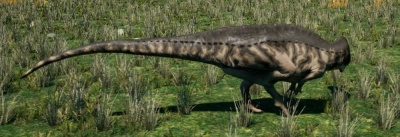Injury
Injury damage in Beasts of Bermuda is a type of damage that slows a player down. It ranges from 0 to 100 percent. At 100 percent, the player will only be able to limp, not exceeding this speed at any time. At 0 percent, the player is healthy and free of injury, and can move as normal. Any range of injury in between will bring down the player's top movement speed. Injury damage was created as a means to allow certain creatures to have an additional, unique advantage and ability while either hunting or defending themselves. While all creatures are capable of dealing some level of injury damage to others, certain ones rely on it heavily as a defensive or offensive mechanism. Often times, slower creatures are capable of utilizing injury damage to either slow down their attacker via infliction of injury to allow escape, or to slow down prey that would otherwise escape them due to speed differentials. It is also a mechanic designed for a unique way to allow |fall damage and tripping to be relevant mechanics that could allow fleeing prey to potentially fall victim to a predator in pursuit, or for fleeing prey to potentially trick a swifter predator into hurting themselves, thus allowing escape.
Sources of Injury Damage
Injury damage can be brought onto the player in several ways.
Tripping will incur injury damage. The amount of injury damage incurred by a trip is 25%, equal to the percentage amount of |HP lost when the the player trips.
|Hard falls will yield injury damage. The harder the fall, the more injury damage the player receives. The amount of injury damage sustained during a fall is equal in percentage to the percentage of HP lost from the fall.
Combat will yield injury damage under certain conditions, explained further below.
Injury Damage from Combat

Under most circumstances, a player must be |hit in the leg in order to receive any injury damage. Injury damage is computed as a constant multiplier multiplied by the square of the inflicting creature's |damage, and then divided by the square root of the victim's |size. This function on infliction of injury damage was crafted for a couple reasons. Most notably, smaller creatures such as the Velociraptor and Utahraptor are almost completely inept at dealing injury damage to their opponents. Other creatures such as the Megalosaurus and Carnotaurus, other light hitting creatures, are also almost completely inept at dealing injury damage as well. The square relationship in injury damage ensures that creatures who rely on many, low damage bites will be very ineffective at inflicting injury damage. Larger creatures are also less effected by injury altogether, allowing harder hits be required in order to slow larger beasts down.
Some creatures, |ones with the Bruiser trait, are capable of inflicting more injury damage and are capable of inflicting injury damage under more lenient scenarios. Most notably, the Pachycephalosaurus is profoundly adept at dealing injury damage as it possesses this trait. It is granted a bonus that multiplies any amount of injury it would otherwise cause by a factor of 10. On top of this, the Pachycephalosaurus is capable of dealing injury to its foes without needing to |strike the legs. Tail hits, however, will never inflict injury damage to the owner, regardless of whether the inflicting player is a bruiser.